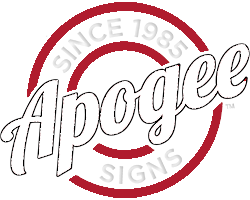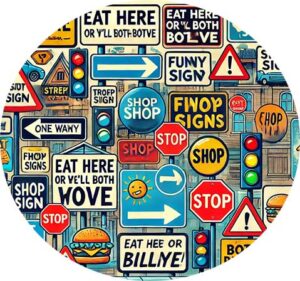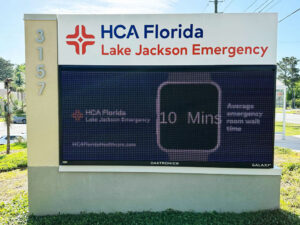
Signage plays a crucial role in marketing by effectively conveying messages, promoting brands, and influencing consumer behavior. It serves as a powerful medium through which businesses can communicate key messages, establish brand presence, and drive engagement. Signage fulfills various key roles in marketing, including enhancing brand visibility and recognition, acting as a communication tool to convey information and promotions, providing guidance to customers, creating differentiation and competitive advantage, reinforcing advertising campaigns, and contributing to the overall customer experience. From captivating visuals to persuasive calls-to-action, signage holds the power to captivate, communicate, and convert, making it an essential component of successful marketing strategies in today’s competitive landscape.
Here are some key roles that signage plays in marketing:
- Brand Awareness: One of the key roles that signage plays in marketing is enhancing brand visibility and recognition. Signage serves as a visual representation of a brand, effectively showcasing its identity, values, and offerings. With its strategic placement and attention-grabbing design, signage catches the eye of potential customers, creating brand awareness and leaving a lasting impression. By consistently presenting the brand’s visual elements and messaging, signage helps reinforce brand recognition, making it easier for customers to identify and recall the brand in the future. The visibility and prominence of signage contribute to building a strong brand presence, distinguishing businesses from their competitors and establishing a sense of trust and familiarity with the target audience. Ultimately, signage serves as a powerful tool in increasing brand visibility, attracting customers, and reinforcing the brand’s position in the market.
- Information and Communication: Signage serves as a medium through which businesses can effectively convey information, messages, and promotions to their target audience. Through well-designed and strategically placed signage, businesses can provide essential details about their products, services, pricing, and special offers. This allows potential customers to quickly grasp key information and make informed decisions. Signage also acts as a silent salesperson, using visually appealing graphics, persuasive copy, and compelling imagery to capture attention and generate interest. Moreover, signage can guide customers within physical spaces, providing directions, highlighting specific areas or products, and creating a seamless and intuitive customer experience. By harnessing the power of signage as a communication tool, businesses can effectively engage their audience, create awareness about their offerings, and drive desired actions, ultimately leading to increased customer engagement and conversion rates.

- Differentiation and Competitive Advantage: Signage creates differentiation and provides businesses with a competitive advantage. In a crowded marketplace, where consumers are bombarded with numerous options, well-designed signage can make a business stand out from the competition. By incorporating unique and eye-catching visuals, signage captures attention, piques curiosity, and leaves a memorable impression on potential customers. It serves as a visual representation of a brand’s personality and values, allowing businesses to showcase their distinct identity and offerings. Effective signage not only differentiates a business from competitors but also communicates its unique selling points, highlighting what sets it apart and why customers should choose its products or services. This differentiation can be achieved through various elements, such as creative design, innovative displays, or engaging messaging. By leveraging signage to create differentiation, businesses can position themselves as industry leaders, attract their target audience, and foster customer loyalty, ultimately leading to sustainable growth and success in the competitive market landscape.
- Location-based Marketing: When customers interact with signage, it goes beyond providing information or promotion; it sets the tone, creates a welcoming atmosphere, and enhances the overall perception of a business. Well-designed and strategically placed signage can create a positive first impression, making customers feel more inclined to explore further. Whether it’s a stylish storefront display, an informative directional sign, or an engaging interactive signage, each element contributes to shaping the customer’s perception and overall satisfaction. Signage can also enhance the navigation experience within physical spaces, guiding customers effortlessly and reducing any potential confusion or frustration. Additionally, signage can evoke emotions, convey the brand’s values, and create a sense of trust and reliability. By investing in signage that enhances the customer experience, businesses can not only increase customer satisfaction but also foster long-term loyalty, word-of-mouth recommendations, and repeat business, thus strengthening their market position and driving sustained growth.
- Reinforcement of Advertising Campaigns: By incorporating consistent branding and messaging across multiple platforms, businesses can create a cohesive and integrated marketing approach. Signage acts as a visual extension of other marketing channels such as print ads, TV commercials, or digital campaigns, reinforcing the core messages and visual identity. When customers encounter consistent branding and messaging in signage, it reinforces their exposure to previous marketing touchpoints, creating a sense of familiarity and reinforcing brand recall. Moreover, signage provides an opportunity to extend the reach of advertising campaigns by reaching a wider audience, including both pedestrians and motorists. By strategically placing signage in high-traffic areas or locations relevant to the target audience, businesses can effectively increase brand exposure and message retention. The combination of diverse marketing channels and the reinforcement of messaging through signage significantly strengthens the impact of advertising campaigns, leading to increased brand recognition, customer engagement, and conversion rates.
- Customer Experience: A catalyst for customer engagement and conversion, signage plays a vital role in marketing strategies. Its effectiveness lies in its ability to capture attention, entice customers, and prompt them to act. By strategically designing and placing signage, businesses can create a powerful call-to-action that drives customer engagement and boosts conversion rates. Whether it’s a vibrant banner, an appealing window display, or an attention-grabbing sign, signage has the potential to captivate passersby and draw them towards the desired action. It acts as a visual cue that communicates promotions, discounts, or limited time offers, creating a sense of urgency and prompting customers to make a purchase. Signage strategically positioned near checkout areas can also lead to impulse buying, encouraging customers to add additional items to their cart. Furthermore, signage acts as a silent salesperson, providing valuable information about products or services and influencing customers’ decision-making process. By leveraging the persuasive power of signage, businesses can effectively increase foot traffic, generate sales, and achieve a higher return on investment. In a world where customer engagement and conversions are paramount, signage stands as a valuable tool that drives business growth and success.

- Cost-Effective Marketing: Compared to traditional advertising channels like television or print media, signage offers a cost-efficient investment with a long lifespan and a wide reach. Well-designed and strategically placed signage acts as a persuasive call-to-action, prompting customers to make purchases, try new products, or take advantage of special offers. Its visual appeal and informative content attract attention and create a sense of urgency, compelling customers to act. Whether it’s a promotional banner, a striking window display, or an attention-grabbing sign, signage has the power to capture the interest of passersby and entice them to explore further. Additionally, signage contributes to impulse buying by strategically placing signage near checkout areas or highlighting limited time offers. By leveraging signage as a tool for customer engagement, businesses can effectively increase foot traffic, stimulate sales, and ultimately achieve a higher return on investment. With its ability to influence consumer behavior and drive conversions, signage stands as an asset in any comprehensive marketing strategy.
- Call-to-Action and Conversion: Signage possesses the ability to drive consumer behavior and boost conversion rates through compelling calls-to-action. By strategically incorporating persuasive messaging and visual cues, signage can effectively prompt customers to take desired actions. Whether it’s enticing customers to make purchases, encouraging them to try new products, or enticing them with special offers, well-executed signage motivates customers to engage and convert. The power of signage lies in its ability to create a sense of urgency, captivate attention, and convey the value proposition of a product or service. By leveraging strategic placement and captivating design, businesses can optimize signage to inspire customer action, resulting in increased conversion rates and tangible business growth.
In summary, signage proves to be an indispensable tool in modern marketing, offering a multitude of benefits for businesses. It plays a pivotal role in enhancing brand visibility, conveying messages, and influencing consumer behavior. Signage captivates audiences, establishes brand presence, and reinforces brand recognition. With its strategic placement and attention-grabbing design, signage effectively communicates information, promotions, and calls-to-action, prompting customers to engage and convert. It differentiates businesses from competitors, contributes to the overall customer experience, and reinforces advertising campaigns. Moreover, signage serves as a cost-effective marketing solution, providing a wide reach and long-lasting impact.
In today’s digital-dominated landscape, the enduring power of signage remains prominent. It captivates, communicates, and converts potential customers, making it an essential component of a comprehensive marketing strategy. By harnessing the potential of signage, businesses can maximize brand visibility, drive customer engagement, and foster sustainable growth. Signage’s ability to leave a lasting impression on consumers is undeniable, making it a valuable investment for businesses seeking to make a significant impact in an ever-evolving marketplace. As businesses continue to navigate the dynamic marketing landscape, signage holds a prominent place in the realm of effective marketing tactics.






